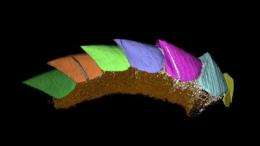Ancient mollusc missing link revealed in 3-D

Scientists have discovered a rare fossil called Kulindroplax, the missing link between two mollusc groups, which is revealed in a 3D computer model, in research published today in the journal Nature.
The researchers have unearthed the worm-like partly shelled Kulindroplax, which they have modelled in a 3D computer animation. Kulindroplax lived in the sea during the Silurian Period, approximately 425 million years ago, when most life lived in the oceans and the first plants were beginning to grow on land. The team found the Kulindroplax fossil, the only one of its kind in the world, in the Welsh borderland, and it is providing the evolutionary missing link between two groups of molluscs and shedding more light on the their early origins.
The study was led by Dr Mark Sutton, from the Department of Earth Science and Engineering at Imperial College London, in conjunction with researchers from the Universities of Oxford, Leicester, Yale and Queen's University Belfast.
Dr Sutton says: "Most people don't realise that molluscs, which have been around for hundreds of millions of years, are an extremely rich and diverse branch of life on Earth. Just as tracing a long lost uncle is important for developing a more complete family tree, unearthing this extremely rare and ancient Kulindroplax fossil is helping us to understand the relationship between two mollusc groups, which is also helping us to understand how molluscs have evolved on Earth."
For over 20 years, scientists have debated the evolutionary relationship between two groups of molluscs called the aplacophorans, which are carnivorous, worm-like, sea-living creatures, and the chitons, which are molluscs that have shell plates for armour and live in the sea or on the seashore– both still live in Earth's oceans today.
The researchers in today's study analysed the 3D model of Kulindroplax and discovered that it had the worm-like body of the aplacophorans, but was partly shelled like the chitons. The combination of features in Kulindroplax confirmed to the team that that aplacophorans and chitons are closely related. Furthermore, the researchers believe that their 3D fossil is the missing link that shows how the worm-like aplacophorans evolved from chiton-like ancestors by losing their shells, providing fresh insight into the mollusc evolutionary tree.
The researchers discovered the Kulindroplax fossil, which is the size of a small caterpillar, in a deposit called the Herefordshire Lagerstätte. This deposit was formed when a cloud of volcanic ash settled through the Siluian seas and entombed a range of species, including Kulindroplax, as almost perfectly preserved fossils.
In order to develop their 3D animation, the team cut the Kulindroplax fossil into 1300 slices, taking digital images of each one, which were fed into a computer. The researchers in the study say this method provides unprecedented detail from the fossils, enabling them to analyse features that have been previously unseen.
More information: "A Silurian armoured aplacophoran and implications for molluscan phylogeny" Nature, 2012. DOI: 10.1038/nature11328
Journal information: Nature
Provided by Imperial College London



















